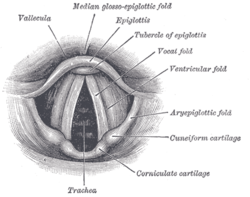The vestibular fold (ventricular fold, superior or false vocal cord) is one of two thick folds of mucous membrane, each enclosing a narrow band of fibrous tissue, the vestibular ligament, which is attached in front to the angle of the thyroid cartilage immediately below the attachment of the epiglottis, and behind to the antero-lateral surface of the arytenoid cartilage, a short distance above the vocal process.
| Vestibular fold | |
|---|---|
 Laryngoscopic view of the vocal folds. (Vestibular fold labeled at center right.) | |
 Cut through the larynx of a horse: 1 hyoid bone 2 epiglottis 3 vestibular fold, false vocal fold/cord, (Plica vestibularis) 4 vocal fold, true vocal fold, (Plica vocalis) 5 Musculus ventricularis 6 ventricle of larynx (Ventriculus laryngis) 7 Musculus vocalis 8 Adam's apple (thyroid cartilage) 9 rings of cartilage (cricoid cartilage) 10 Cavum infraglotticum 11 first tracheal cartilage 12 Windpipe (Trachea) | |
| Details | |
| Identifiers | |
| Latin | plica vestibularis, plica ventricularis |
| TA98 | A06.2.09.008 |
| TA2 | 3196 |
| FMA | 55452 |
| Anatomical terminology | |
The lower border of this ligament, enclosed in mucous membrane, forms a free crescentic margin, which constitutes the upper boundary of the ventricle of the larynx.
They are lined with respiratory epithelium, while true vocal cords have stratified squamous epithelium.
Function
editThe vestibular folds of the larynx play a significant role in the maintenance of the laryngeal functions of breathing and preventing food and drink from entering the airway during swallowing. They aid phonation (speech) by suppressing dysphonia. In some ethnic singing and chanting styles, such as in Tuva, Sardinia, Mongolia, South Africa, and Tibet (...) the vestibular folds may be used in co-oscillation with the vocal folds, producing very low or high pitched sounds (most of the time, one octave higher). Conversely, people who have had their epiglottis removed because of cancer do not choke any more than when it was present.[1][2]
Society and culture
editThey have a minimal role in normal phonation, but are often used to produce deep sonorous tones in Tuvan throat singing,[3] as well as in musical screaming and the death growl singing style used in various forms of metal. Simultaneous voicing with the vocal and vestibular folds is diplophonia. Some voice actors occasionally employ small amounts of this phonation for its dark, growling quality while portraying a "villainous" or antagonistic voice.[citation needed]
See also
editReferences
editThis article incorporates text in the public domain from page 1079 of the 20th edition of Gray's Anatomy (1918)
- ^ Vestibular fold flap for post-cordectomy laryngeal reconstruction; Mamede, Ricz, Aguiar-Ricz, Mello-Filho; Abstract
- ^ A self-sustained vocal-ventricular phonation mode: acoustical, aerodynamic and glottographic evidences ; L Fuks, B Hammarberg, J Sundberg; [1]; "Trans-oral partial epiglottidectomy to treat dysphagia in post-treatment head and neck cancer patients"; Jamal, Erman, Chhetri; [2]
- ^ Fuks, Leonardo (1998), From Air to Music: Acoustical, Physiological and Perceptual Aspects of Reed Wind Instrument Playing and Vocal-Ventricular Fold Phonation, Stockholm, Sweden, retrieved 2010-01-05
{{citation}}: CS1 maint: location missing publisher (link)
External links
edit- lesson11 at The Anatomy Lesson by Wesley Norman (Georgetown University) (larynxsagsect, larynxmembranes)
- Anatomy photo: respiratory/airways/larynx1/larynx4 - Comparative Organology at University of California, Davis